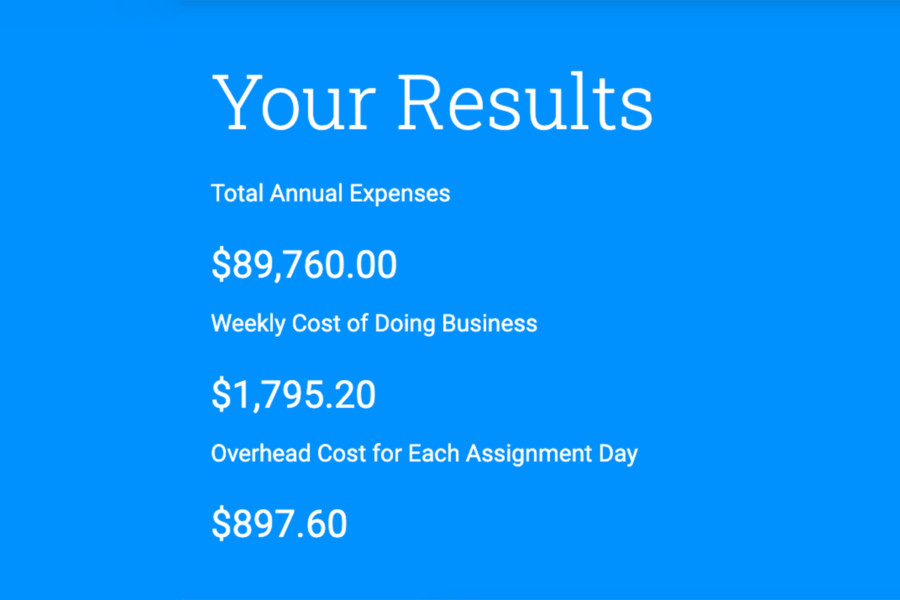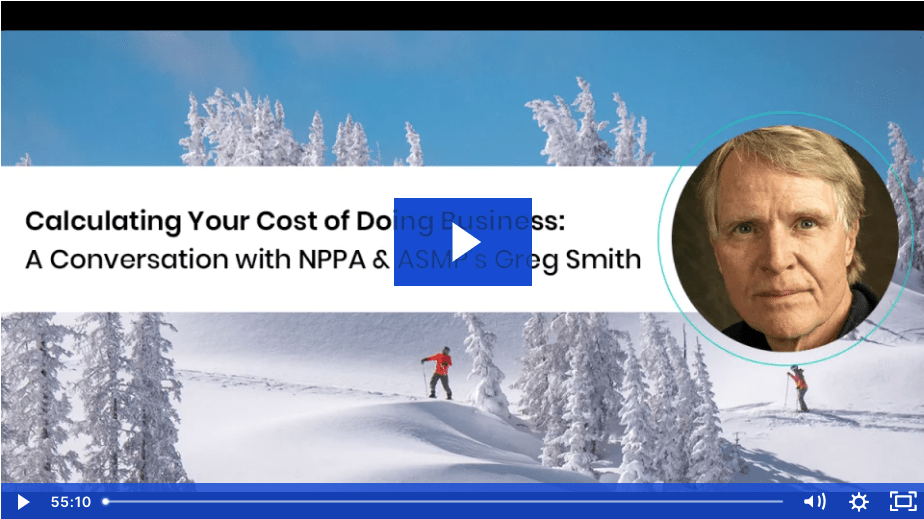
WATCH: How to Calculate Your Cost of Doing Business
When it comes to growing your photography business and managing your money, there is a lot to consider. How are you calculating your costs and what are the main priorities you should focus on as you acquire equipment and cater to clients?
We sat down with Greg Smith, a current member of ASMP Colorado and a former national board member of NPPA, to discuss his experience in the industry and his top tips for thinking critically about how you should spend money on your photo business.
Watch the entire on-demand recording below to learn:
- How to calculate your costs, including some quick figures to get you started
- Tips for how to adjust costs and income sources
- How to use NPPA’s Cost of Doing Business Calculator
- Advice on pricing for profit
On-Demand Webinar: Calculating Your Cost of Doing Business with NPPA & ASMP’s Greg Smith

Our Q&A with Greg
Thank you to everyone for submitting questions for NPPA and ASMP’s Greg Smith. Have any additional questions? Tweet us @photoshelter and let us know!
This Q&A was lightly edited for clarity and length.
Tell us a little about yourself and your background.
GS: Well, my background is as a photojournalist. I have two degrees effectively in that: a Bachelor’s of Science and Journalism, and then a Masters in Visual Communication, both from Ohio University. I went right out and started working as a photojournalist, then worked as an editor and then worked a lot in PR, too. So my journey has been broad.
For those who don’t know about NPPA or ASMP, do you mind giving a little bit of background about those organizations?
GS: Sure. Both organizations were started close together. I believe ASMP (American Society of Media Photographers) was started in 1944 and NPPA (National Press Photographers Association) was started in 1946. They actually initially aimed at some of the same types of work. ASMP was started primarily by the Life photographers as they were risking their lives and felt they were not being compensated adequately enough during World War II. They banded together and tried to get a better deal out of the Time/Life work. That spread, and I’d say ASMP has more commercial and corporate photographers in it, although it’s a very broad range of photographers. It’s the more expensive of the two organizations to be a member of. I don’t know that it’s more elite, but it is a little bit broader.
NPPA is focused on photojournalists, both TV and still photographers. And it was formed in 1946 for some of the same reasons… It was an organization of comradery, initially. And as things progressed, that’s when I got more involved. I could see that we were going to be freelancers, not staffers. I could see this in the late 90s, the AP contract and New York Times contract, which I fought very hard for; they were the writing on the wall that the folks were going to want more rights because we had the web out there.
That’s when I pushed NPPA to address freelancers’ rights a little bit better, and I made some progress. I think the organization is much closer to that now. It was a group of old white men, including myself. And I think that the leadership has changed a great deal, and is focused on the folks who are actually on the street right now, trying to make it work.
They’re both good organizations. I don’t know that I could do without my membership in either one. It’s also part of my cost of doing business, and it works for me.
Can you tell us about the copyright website you use and recommend?
GS: It’s eco.copyright.gov. That’s the electronic copyright office. And from that point, if you have an account, you can go ahead and register a copyright. It’s not hard to set up an account. It is precise work. You have to go through about 10 or 12 screens to register a copyright for a group of images, but that’s probably how you want to do it.
I always try to register my images as unpublished, that is before they go to a client for use. Although defining what is published and what is not is a gray area. There are lots of gray areas that you need to study. I’ve done a lot of study on copyright, and there are still choices to be made. But there’s good guidance right now. Go to eco.copyright.gov, or just copyright.gov, and then click through to the electronic copyright office. There you can register. You just upload your images and you pay your money, which is $55 for a group of images, either published or unpublished. You can register up to 750 at a time.
As part of your cost of doing business, do you subscribe to any online monitoring service for copyright violations?
GS: I do not. I think if I were more active, I might. I’ve got reservations about such organizations. I don’t know what’s legit and what isn’t there. But it borders on ambulance chasing for me. And these organizations are often accused of being copyright trolls. There have been abuses. And if you sign up for one of these things, they don’t agree to take every case that you think might be viable. They’re only going to go for the ones that they think are going to make them money. And they’re going to take a good chunk of your money.
What you have to weigh is whether this takes a burden off you for policing your work, how important it is for you to do your work, and whether it will get you more money than you’re getting otherwise, and not cause you more harm in the market. You could get a bad reputation by having an attorney out there over representing. So it’s a balancing act. I can’t recommend one, I can’t recommend against another.
Shouldn’t we avoid day rates because they are a measure of time instead of value? If I can produce better images in a single hour than a different photographer can produce in a day, shouldn’t I price based on what I can deliver as opposed to how much time it takes me?
GS: I would say it’s day rate versus hour in that question. I get paid for the assignment, an assignment rate. You can call it a day rate, you can call it an assignment rate, but they’ve got me there for that assignment. If I can get that assignment done in two hours, then I’m more valuable.
So I agree the day rate is appropriate for when you have an assignment to cover or an event of some sort. It’s going to last a period of time, and you’ve got to be there. Otherwise, I would call it an assignment rate. And you’re going to produce the pictures they need, it’s going to take as much time as you have estimated, more or less. If it takes more time, then you’re hurting a little bit, if it takes less time, you’re shining.
Generally speaking, when you’re billing by the hour or saying it’s going to be a full day, the day is eight hours, and you get done in six, the client’s going to say, “Hmm, wow. I paid for eight.” So I hear you. I hear you exactly. It depends on what the type of assignment is. But in general I do call it a creative fee or an assignment fee, not a day rate.
I have a few commercial clients who all know each other and have different budgets. When I’m pricing them out, I want to be fair enough so that they don’t talk and I lose out on reputation, but I want to make more money on the ones with bigger budgets. How do I navigate those conversations?
GS: I’d say you’re getting outside my skill set. That’s a toughie. You’ve just got to feel them out. One of my first questions, if I’m offered a project or offered to bid on a project is, “what’s your budget?” And I try to come in below that if it’s realistic, and if it’s not realistic, I either say, “Hey, I can’t bid on that.” Or I try to talk them up. So it’s all about negotiating.
Just because a client has a lower budget doesn’t mean that you can do the job. Maybe you can’t afford to do it. Maybe somebody who is more eager for having done a job than for having the money, just to get something under their belt – maybe they can do it. And the client’s probably going to get a different value.
If you calculate your costs and determine you need to raise your prices, what’s your advice on doing that with existing clients?
GS: The only way I’ve been successful with this is to annualize it and say, “In October, November, December, we’re raising our rates by X percentage points, or by the specific number starting in the new year. I’m sure you understand that all our costs have gone up, and I have to make my budget.”
The reality is if that’s not a regular client, or if it’s a particularly cheap client, you might lose them. So that’s why constant marketing, constantly looking to step up the ladder, is so important to a career.
I’m just starting out with my freelance business. Understanding that costs can grow quickly, if you had to choose two things to keep the closest eye on, what would they be and why?
GS: I think for most photographers, it’s going to be equipment as number one. Do you need to have three top of the line cameras? Or can your backup camera cost $1,000 instead of $4,000 or $6,000? Do you need a backup camera? Do you need any cameras if you’re a studio shooter? Can you rent? If I’m in New York, I might want to rent everything, because I walk down the street and get it. And then I just bill the rental back to the client. So I think that’s your biggest worry.
Your next worry, in general, is overhead. I have a $300 a month office that doesn’t really pay for itself, but I have stuff I need to store there. So it’s a real balancing act. I work more from home than from my nearby office, but I also kind of need it. It’s $3,600 a year that is not really making me money.
But control your overhead. If you’ve got an office you can’t afford, work out of your car. Or work from your bedroom. And keep that equipment lean and mean.
Look at cinematographers. Cinematographers or an assistant, they own a light meter. That’s it. A light meter and an iPad. And then you rent it all. You bid the job for what you’re going to need for that particular job. I don’t think that’s going to work too well for photojournalism, but it could for a studio photographer. It could for many commercial photographers. Own the package that’s minimal, and then rent what you need and charge it to the client.
If you want to dive into more of Greg’s insights and learn more about the Cost of Doing Business Calculator, watch the full on-demand webinar above!
